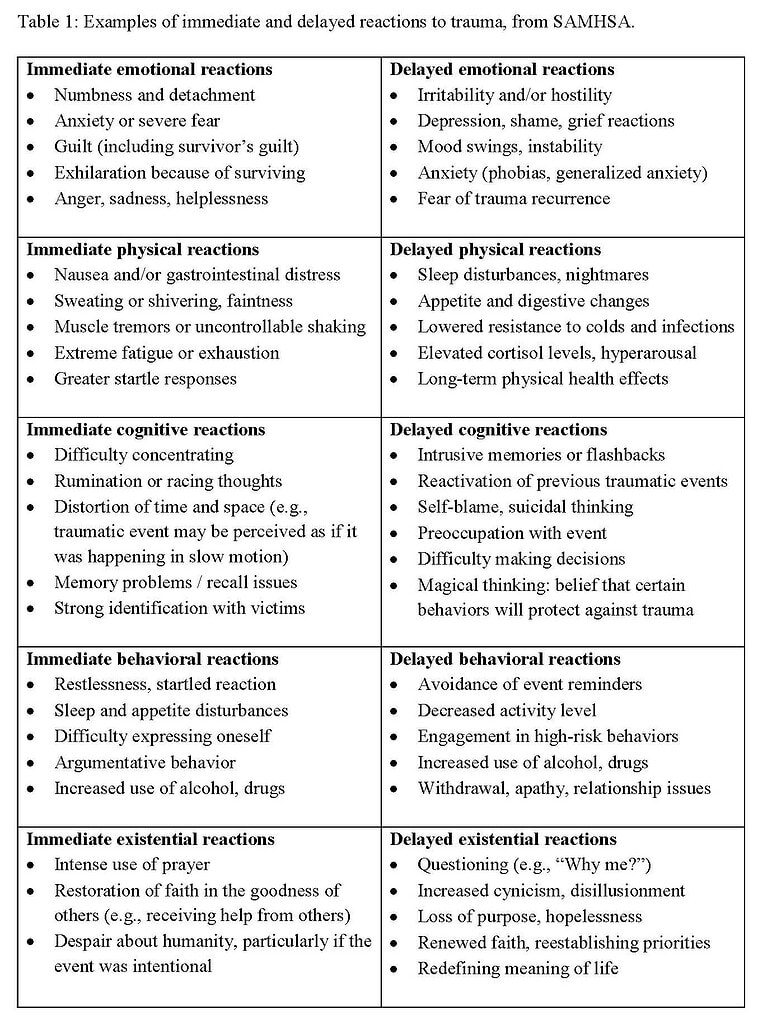
Trauma Awareness Month
May is National Trauma Awareness Month in the US. Will you recognise the signs of traumatic stress?
By Holly Gibbs
Content Warning: This article contains descriptions of traumatic events.
According to the U.S. Substance Abuse and Mental Health Services Administration (SAMHSA), people who have experienced trauma are at an elevated risk for substance use disorders, including mild to severe symptoms, mental health disorders, including symptoms of depression, anxiety, and post-traumatic stress disorder (PTSD), and physical conditions, including eating and sleep disorders. This is especially true for people who have experienced trauma in childhood.
As a trauma survivor myself, I struggled with depression, anxiety, substance use disorders, and toxic relationships for many years. Even as a happily married adult and successful public figure, I secretly struggled with binge drinking; that is, until I finally learned about trauma and recognized its long-term effects on my health and well-being. I began to practice regular healing habits, including yoga, meditation, and mindfulness, and I was finally able to quit drinking.
As a person working in the healthcare industry, I know there is a push to educate medical providers about the connections between trauma and long-term negative health outcomes. However, as a patient, I believe there needs to be an equal push to educate the public. Knowledge is power. And once I had the knowledge, I had the motivation to do something about it.
In the United States, May is National Trauma Awareness Month. In recognition of this month, I’d like to introduce readers to the concept of trauma and traumatic stress, as described by the U.S. Substance Abuse and Mental Health Services Administration (SAMHSA) in its Treatment Improvement Protocol (TIP) 57: Trauma-Informed Care in Behavioral Health Services.
Let’s begin with a description of trauma.
SAMHSA frames its concept for trauma around three Es: an event, the experience of that event, and the effects. Per SAMHSA, individual trauma results from an event, a series of events, or a set of circumstances that is experienced by an individual as physically or emotionally harmful or life-threatening and has lasting adverse effects on the person’s functioning and well-being. This includes a person’s mental, physical, social, emotional, and spiritual well-being.
Many of us experience trauma in our lifetimes. It can affect people of every age, gender identity, sexual orientation, race, ethnicity, religious affiliation, and geographic region. Trauma can directly or indirectly affect individuals, families, groups, communities, specific cultures, and generations. For example, a person may be directly affected by an event, such as a person who is injured in a drunk driving accident, as well as the driver who caused the tragedy. Or a person may be indirectly affected if they witnessed or heard about the event or its effects.
Per SAMHSA, people typically experience direct trauma as more harmful or life-threatening than indirect trauma; however, witnessing another person’s pain can at times be equally traumatizing. For example, parents may “internalize the pain and suffering of their children” if their children are undergoing traumatic experiences. The impact of indirect trauma depends on several factors, including the person’s closeness to the event, their relationship to the victim, the degree of helplessness surrounding the experience, and the person’s exposure to the aftermath.
Remember, whether it’s experienced directly or indirectly, the type of event doesn’t determine whether it is traumatic. It’s the individual’s experience of that event. In other words, two people can experience the same event, series of events, or a set of circumstances with very different effects. For one, the experience may feel physically or emotionally harmful or life-threatening and may cause lasting adverse effects. For the other, this may not be the case. In fact, the other person may feel like the event is normal, simply inconvenient, or even exciting.
SAMHSA provides the following example scenarios:
- A child removed from an abusive home may experience this differently than a sibling
- One refugee may experience fleeing one’s country differently from another refugee
- A military veteran may experience deployment to a war zone differently from another

Stress is a universal part of the human experience; however, stress can become traumatic when it overwhelms a person’s ability to cope and recover. The term traumatic stress refers to a wide range of reactions that a person may experience after trauma. It’s important to know that reactions to trauma can be both immediate and delayed. See Table 1 (above) for examples.
If you experience signs or symptoms of traumatic stress, please don’t suffer in silence. Seek guidance from your medical provider. If possible, seek support from a therapist as well. For free, confidential 24/7/365 mental health and substance use disorder treatment referral and information services (in English and Spanish) in the U.S., call the SAMHSA National Helpline at (800) 662-HELP (4537) or visit www.samhsa.gov/find-help/national-helpline.
_____________________________
This article was reviewed by Joseph Stoklosa, MD, clinical director of McLean’s Psychotic Disorders Division and assistant program director of the Massachusetts General Hospital/McLean Adult Psychiatry Residency Training Program.








